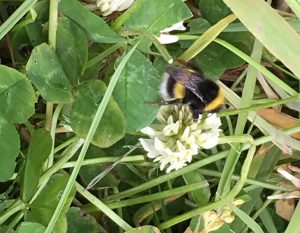Stating the case for reseeding with white clover this autumn
September 3, 2020
With the reseeding season upon us once again, the question is always asked within the CAFRE Beef and Sheep Business Development groups, “Should I include white clover in my grazing mix”? While many Beef and sheep farmers have embraced all the benefits of clover rich swards others have just been happy with grass only swards.
What are the main benefits of white clover rich swards to the Beef and Sheep farmer?
- Improved animal performance due to improved nutritional composition see Table 1. Research has shown that lambs have the potential to grow 25 % faster on grass clover swards and cattle 10 % better than on grass only swards. Palatability is also improved with white clover in the sward leading to higher intakes.
- AFBI research has shown that under ideal conditions clover can fix up to around 150 kg of nitrogen per hectare. However under farm conditions this level may not always be achieved but it is free nitrogen nonetheless that cannot be ignored.
- Improves soil structure as the root system of the white clover plant produces more gaps between soil particles which can enhance movement of nutrients.
- Higher mineral content.
Table 1. Nutritional content and quality characteristics of White clover and Perennial ryegrass.
| White clover | Perennial Ryegrass | |
| Digestibility (D-value) (%) | 75-82 | 65-75 |
| Crude Protein (%) | 27 | 17 |
| Dry matter (DM) intake by sheep (kg/day) | 1.9 | 1.4 |
| Calcium content | 1.6 | 0.6 |
| Magnesium content (%) | 0.18 | 0.16 |
| Phosphorous (%) | 0.6 | 0.3 |
| Copper (parts / million) | 10 | 6.5 |
| Selenium (parts/million) | 0.6 | 0.2 |
Growth pattern of white clovers
White clovers start growing in the spring when temperature reach 8 degrees centigrade as opposed to grass that can grow from 5 degrees centigrade. Therefore spring growth is usually lower for white clovers than for grass and the peak season for clover production is during the mid to late season as grass production starts to fall away. Consequently grass and white clover tend to complement each other fairly well. Plant breeders have focused a lot of their work over the last 20-30 years in producing more persistent varieties that are more productive earlier in the season.
Clover size
White clovers are categorised according to their leaf size see Table 2.
Table 2. White clover leaf size and practical uses
| Leaf size | Leaf area | Uses |
| Small | Less than 700 mm2 | Continuous sheep grazing |
| Medium | 700-1000 mm2 | 1.Rotational sheep grazing2. Continuous cattle grazing3.Cutting |
| Large | More than 1000 mm2 | 1.Cutting2. Rotational cattle grazing |
Smaller varieties in general tend to be less productive but more resilient, while large leaf varieties generally are more productive but less resilient and persistent. Predominantly sheep grazing mixes contain small and medium leaf clovers while cattle mixes tend to have medium and large leaf clovers.
Companion grasses and seed rate
Intermediate and late heading perennial ryegrasses, especially tetraploids are a good companion with white clover. Tetraploids having a slightly more open swards which encourages the clover to spread. Avoid very dense ryegrasses that are prostrate in their growing nature as they are very competitive and restrict clover spread. Approximately 20-30 % of the total mix should ideally be tetraploid grasses.
A 14 kg bag of grass seed should typically have up to around 1 kg of white clover mix in it, which is generally sufficient. Higher clover seed rates can be advised with late sowing or poorer cultivation techniques.
Sowing and establishing a grass clover sward within a conventional reseed
- Burn off the previous pasture with glyphosate.
- Aim for level ploughing that’s has buried all surface debris.
- Apply lime as needed but aim to for ph of 6.0-6.5. Clover does not thrive in acidic soils.
- Apply P and K as recommended from soil analysis.
- Aim for a clean level, firm seedbed, ring rolled before sowing.
- 5-10 mm is the optimum sowing depth so as not to bury the seed too deep
- Broadcasting is generally one of the most reliable methods of establishing the sward.
- A very light harrow is needed followed by the ring roller.
Timing
Aim to have it sown by the end of August as clover stolen production must start before winter. Later sowing can be carried out but the clover seed rate may have to be increased.

Post sowing management
Be vigilant for slugs as the sward starts to germinate. Weeds may also have to be controlled if at a high level. A light grazing is recommended in late autumn/early winter. All young seedling and establishing plants are not very tolerant of poaching.
Summary
White clover rich swards are a highly nutritious feed, for both cattle and sheep which results in improved intakes and animal performance. Their ability to fix nitrogen provides a significant saving on bagged nitrogen fertiliser that cannot be ignored. Many lowland beef and sheep farmers could integrate clover rich swards into their current system and enjoy many of these benefits with relatively few drawbacks.
